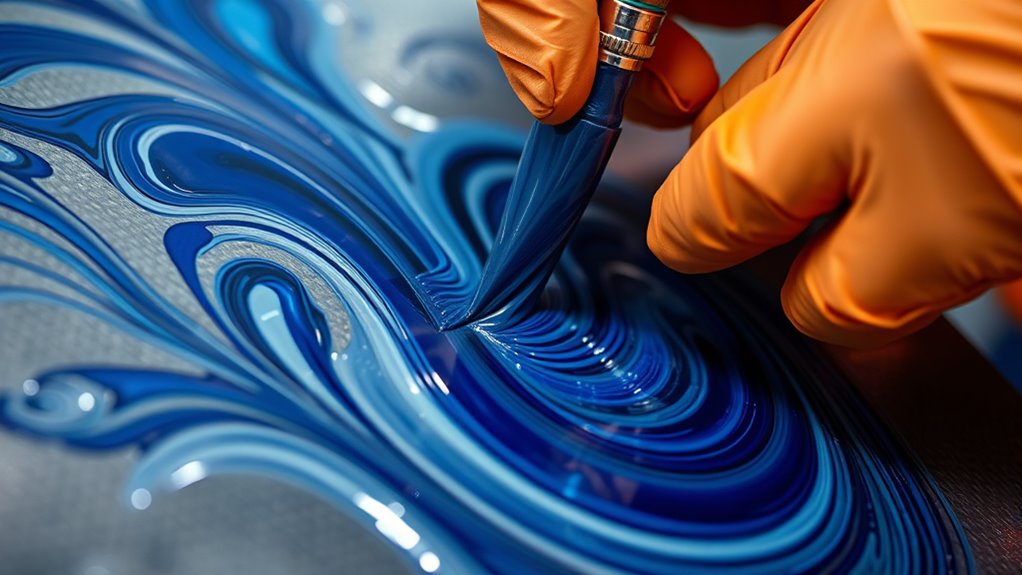When working with thick coatings and high-viscosity materials, you should measure viscosity accurately first. Use specialized tools or pre-warm the material to make application easier. Prepare surfaces thoroughly, ensuring they’re clean and dry, and choose appropriate tools like notched spreaders or heated sprayers. Applying thin coats and maintaining consistent environmental conditions help achieve even coverage and strong adhesion. If you want to master these techniques, the next steps will guide you through the details.
Key Takeaways
- Measure viscosity accurately before application to select proper equipment and techniques.
- Pre-warm or thin high-viscosity materials to improve flow and ease of application.
- Use specialized tools like high-pressure sprayers or heated applicators for even coating.
- Prepare surfaces thoroughly to ensure adhesion and reduce application difficulties.
- Adjust environmental conditions and curing processes to optimize performance of thick coatings.

Working with thick coatings and high-viscosity materials can be challenging, but understanding their properties helps you achieve better results. One key aspect to *assess* is viscosity measurement, which determines how thick or runny a material is, directly impacting how you apply it. When working with such substances, you need to select the right tools to accurately measure viscosity, such as a viscometer or a rotational rheometer. Proper measurement *guarantees* you know exactly how the material will behave during application, helping you avoid issues like sagging, uneven coating, or poor adhesion.
Accurate viscosity measurement ensures optimal application of thick, high-viscosity materials and prevents common coating issues.
Application techniques are *essential* when handling high-viscosity materials. Since these substances resist flow, standard brushing or spraying methods often won’t work effectively. Instead, you might need specialized equipment, like high-pressure spray systems or heated applicators, to get a smooth, even coat. Pre-warming the material can lower its viscosity temporarily, making it easier to apply without compromising its performance once cooled. Always test small batches first to determine the *best* temperature and application method, preventing waste and *guaranteeing* quality.
You should also *think about* the environment when working with thick coatings. Temperature and humidity influence viscosity, so maintaining a consistent workspace helps in achieving uniform application. For instance, colder temperatures increase viscosity, making the material thicker and harder to spread, while warmer conditions can make it too runny. Adjust your application techniques accordingly, perhaps by modifying the equipment settings or applying multiple thin coats instead of a single heavy layer. This approach minimizes sagging and drips, giving you a more controlled finish.
Proper surface preparation is *indispensable* too. Clean, dry surfaces allow the high-viscosity material to adhere better and reduce the chances of defects. Use appropriate primers or surface treatments if necessary, especially when working with challenging substrates. During application, take your time to ensure even coverage, and consider using tools like notched spreaders or specialized rollers designed for thick coatings. These can help distribute the material evenly, reducing application time and waste.
Additionally, understanding the thermal properties of high-viscosity materials helps optimize application conditions and improve workability. These factors can significantly affect viscosity and curing times, influencing overall results. After applying the coating, curing conditions matter. Follow manufacturer guidelines for drying times and environmental conditions to *attain* *maximum* performance. Properly applied high-viscosity materials will provide durable, high-quality results if you measure viscosity accurately and use the right application techniques. By understanding how these substances behave and adjusting your methods accordingly, you’ll find that working with thick coatings becomes more manageable and yields professional results every time.
Frequently Asked Questions
What Safety Precautions Are Necessary When Handling High-Viscosity Materials?
When handling high-viscosity materials, you should always wear personal protective equipment like gloves, goggles, and respirators to avoid skin and eye contact. Make certain spill containment measures are in place to prevent leaks and accidents. Handle the materials carefully, and clean up any spills promptly using appropriate procedures. These precautions protect you from potential hazards and keep your workspace safe during the process.
How Do Temperature Changes Affect Thick Coating Application?
Ever wondered how temperature shifts impact your coating process? When temperature stability isn’t maintained, thick coatings can become inconsistent, leading to uneven application. Thermal expansion causes materials to expand or contract, affecting adhesion and finish quality. You need to control ambient temperature and curing conditions carefully. By doing so, you guarantee your high-viscosity materials flow smoothly, adhere properly, and result in a flawless, durable coating.
Can Standard Equipment Be Used for All Types of Viscous Materials?
You can’t use standard equipment for all viscous materials because equipment versatility is limited, and not all tools are compatible with every high-viscosity substance. To ensure proper application, you need to take into account material compatibility, selecting equipment designed specifically for different viscosities. This approach helps achieve quality finishes, prevents clogs, and reduces downtime, making sure you get the best results for each coating type.
What Are Common Troubleshooting Methods for Application Issues?
If your application suddenly turns into a rollercoaster ride, start troubleshooting immediately. Check for application consistency—are the coatings applied evenly? Confirm your equipment is calibrated perfectly, because even minor deviations can cause major issues. Clean and inspect all components, and adjust settings as needed. Sometimes, just a simple calibration fix or cleaning can turn your process from chaos to smooth sailing, saving time and material.
How Does Viscosity Influence Drying and Curing Times?
Viscosity measurement directly impacts drying and curing times because higher viscosity coatings take longer to release solvents and air, delaying these processes. When your material has high viscosity, expect slower drying and curing, which can affect finish quality and process efficiency. To maintain curing consistency, monitor viscosity regularly and adjust formulations or application techniques accordingly. This helps guarantee ideal drying times and a uniform, durable finish.
Conclusion
By understanding the unique challenges of applying thick coatings and high-viscosity materials, you can optimize your techniques for better results. Some experts believe that adjusting formulation properties, like thinning agents, can substantially improve application, but recent studies suggest that surface preparation and controlled application methods are just as vital. Embracing these insights helps you achieve a smoother finish and longer-lasting coatings, proving that a combination of science and skill truly makes the difference in high-viscosity material work.










